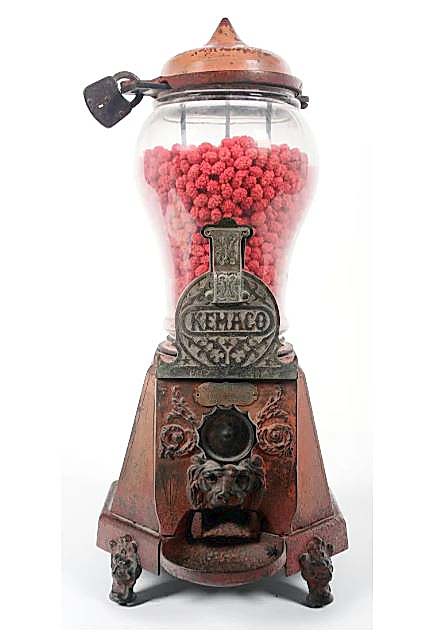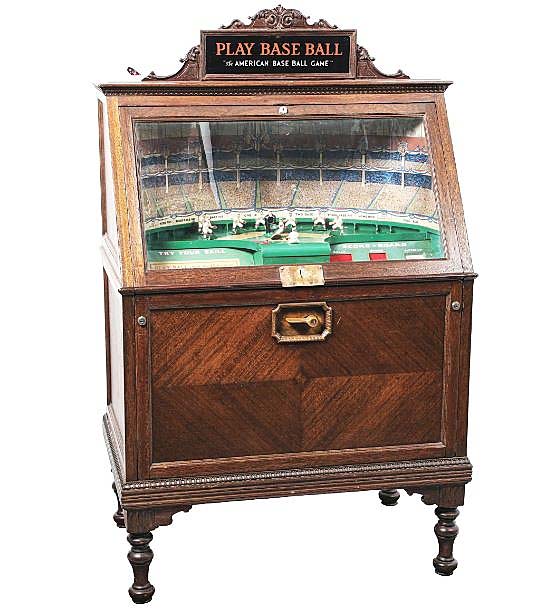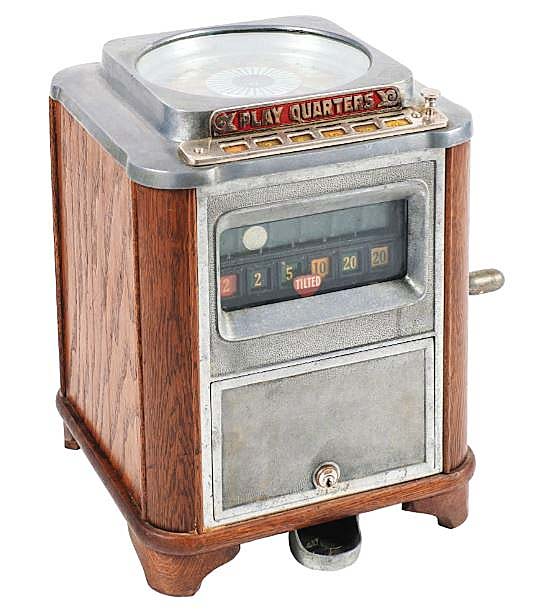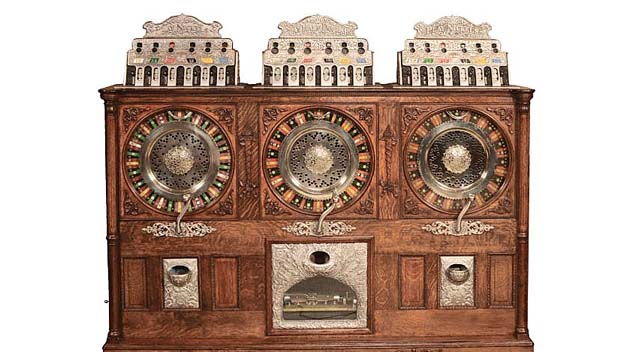#Quirky #Fun #Morphys #CoinOp #Advertising #Auction #Grosses #Million #Antiques #Arts #Weekly

The sale’s top lot was a rare and highly sought-after Caille Bros musical Triple Eclipse upright slot machine whose design incorporated three separate machines — accepting 5¢, 50¢ and 5¢, respectively — in one oak cabinet. It sold for $147,600, figuring prominently in Nevada’s long gambling tradition. Discovered in a Nevada warehouse in the late 1960s, it was made sometime between 1902 and 1904, the earliest of only four extant examples of this particular model.
Review by W.A. Demers; Photos Courtesy Morphy Auctions
LAS VEGAS — As predicted, the sale’s top lot in Morphy’s April 11-13 coin-op and antique advertising auction was a rare and highly sought-after Caille Bros musical Triple Eclipse upright slot machine whose design incorporated three separate machines — accepting 5¢, 50¢ and 5¢, respectively — in one oak cabinet. It sold for $147,600 in a sale that grossed $3,936,000 at press time and that likely will surpass $4 million when anticipated post-auction purchases are added. Figuring prominently in Nevada’s long gambling tradition, the machine was described as an “artistic masterpiece with its all-original castings and most of its original nickel plating.” It was made sometime between 1902 and 1904, and its serial number confirmed it is the earliest of only four extant examples of this particular model. Following its period of service as a gambling device, the machine became part of the Dobby Doc collection, which was amassed in the 1930s and 1940s and lay dormant until it was discovered in a Nevada warehouse in the late 1960s. Dan Morphy, founder and president of Morphy Auctions, said, “I was very pleased with the results and the turnout. We had more than 100 live attendees, including a lot of new bidders and buyers — that is always a huge positive on many levels. We also had a number of potential consignors come to meet us and see our operation. I can say with confidence that our fall coin-op and antique advertising sale is already shaping up to be a blockbuster.”
The 1,919-lot sale, which was burgeoning with rare machines from notable collections, some quirky and fun pieces, and including items from the lifelong collection of Bill Howard and several that appear in the Bill Enes antique advertising reference book Silent Salesman Too.

Ornately decorated, the Kemaco Lion 1¢ peanut vending machine, selling for $19,580, featured a “lantern” globe and a facade adorned with a bas-relief lion’s head. It stood 21 inches tall. Bill Enes included this machine in his reference book Silent Salesman Too.
Planters Peanut fans had two dozen lots that were devoted to freshly roasted peanuts, including the Mr Peanut cast iron roaster/dispenser that was made as a point-of-sale display for Planters Peanut Co. By means of an electric motor, a top-hatted, three-dimensional Mr Peanut figure straddled the transparent roaster renders the illusion that he is operating the machine. One of very few of its type known to exist, it stood 89 inches tall and roasted its estimate of $30/60,000 to achieve a scorching $135,300.
Also “nutty” was ornately decorated Kemaco Lion 1¢ peanut vending machine. Its unusual form featured a “lantern” globe and a facade adorned with a bas-relief lion’s head. It stood 21 inches tall and was included in Enes’ tome Silent Salesman Too. Estimated $10/20,000, it sold for $19,580.
The Caille Brothers were not finished entertaining. A circa 1910, Detroit, Mich., extremely rare “Loving Cup” dual wheel slot machine took $79,950. Available with or without the side vender, the machine included original wheels and castings and was in working condition.
Also from the early 1900s came a Watling Manufacturing Co.’s Double Buffalo upright slot machine. Stunning to behold, it featured the original preserved quartered oak cabinet with ornate Buffalo coin heads on top, detailed front corner castings and applied front carving. Playing perfectly, it paid out $56,580 for its consignor.

Baseball memorabilia collectors stepped up to the plate and bid this rare floor model arcade machine to $54,120. Manufactured by the Amusement Machine Co. and representing the 1927 World Series, it displayed a full infield populated with cast iron players, including a batter and umpire, and was backed by an original cardboard lithographed stadium with a full crowd.
Manufactured by the Amusement Machine Co. and representing the 1927 World Series, it displayed a full infield populated with cast iron players, including a batter and umpire, and was backed by an original cardboard lithographed stadium with a full crowd. The 1¢ floor model with a glass slant front pitted the Pittsburgh Pirates against the ultimately victorious New York Yankees. The machine was unrestored; still, baseball memorabilia collectors stepped up to the plate and bid it to $54,120.
Fetching $52,890, a 1928 Princess Doraldina fortune teller machine, manufactured in Rochester, N.Y., featured Doraldina, sitting behind the window with a row of cards laid out in front of her. The lifelike seer wore period clothing, with a wax head and costume jewelry. When a coin was deposited, she would move her hands over the cards, her head would articulates and her body would appear to breathe, before delivering one’s fortune in the form of a card through the slot below the window.
A circa 1904 original upright slot machine from Mills Novelty called the Big Six hit the jackpot at $49,200. It featured a mahogany cabinet with original six-way coin head, raised panels, colorful tin wheel with chipped glass front, with a jackpot musical accompaniment. It came out of a 50-year collection, where it had been kept the past 40 years.

The circa 1932 Caille Brothers Aristocrat from the lifelong collection of Bill Howard recreated casino action, spinning to a final price of $39,360. The wood cabinet with aluminum castings housed a fully operational roulette wheel with 25¢ operation.
Gambling afficionados could recreate casino action with the circa 1932 Caille Brothers Aristocrat in original, unrestored condition. From the Howard collection, the wood cabinet with aluminum castings housed a fully operational roulette wheel with 25¢ operation. It spun to a final price of $39,360.
In the quirky category, not to be missed was an 1890s Vichy automaton of a young man serenading a crescent moon. Fully functional and in excellent condition, the 20-by-22-inch entertainer also came from the Howard collection and beat its $5/10,000 estimate by twofold, attaining $20,910.
Also quirky and fun fromt the Howard collection was a phenomenal 6-foot-tall papier mache advertising figure for Edgewood Whiskey dating to the early Twentieth Century. A clockwork mechanism operates his bloodshot eyes that move back and forth. The advertisement on his front shirt read “I drink Edgewood Whiskey everywhere.” Rotating left to right, his bloodshot eyes were a little creepy. The piece sold for $18,450.

A 5¢ Hercules novelty “Shoot The Clown” coin-op machine, circa 1930, was a rare arcade game that required skill, vended gum, rang a bell with success and “possessed all the traits of a trade stimulator,” according to cataloging. The successful bidder deposited $16,605.
A circa 1930 5¢ Hercules novelty “Shoot The Clown” coin-op machine that derived its entertainment from a number of factors. Requiring skill, it also vended gum, rang a bell with success and “possessed all the traits of a trade stimulator,” according to cataloging. The player receives five shots for each coin; the object was to shoot down both hands of the clown and then the clown himself. Accomplishing this, the player knocks him off his seat and the bell rings, announcing a winner. If you fail, well, you can always deposit another coin for another five shots. For this lot, the winning bidder deposited $16,605.
The Howard collection also contributed a papier mache likeness of Uncle Sam in all original condition with all original paint. Deemed a fantastic piece of Americana, it was bid to $7,380.
Additional highlights included a circa 1920s Falstaff Bottled Beer self-framed tin lithograph with automotive and wagon graphics at $7,380; a bridgemaker’s shaving mug with the name “W.B. Finnegan” in gold gilt and a detailed image of the Manhattan Bridge at $5,280; and a Barnum & Bailey circus poster that sold for $5,760.
Prices include the buyer’s premium as stated by the auction house. For more information, www.morphyauctions.com or 877-968-8880.




